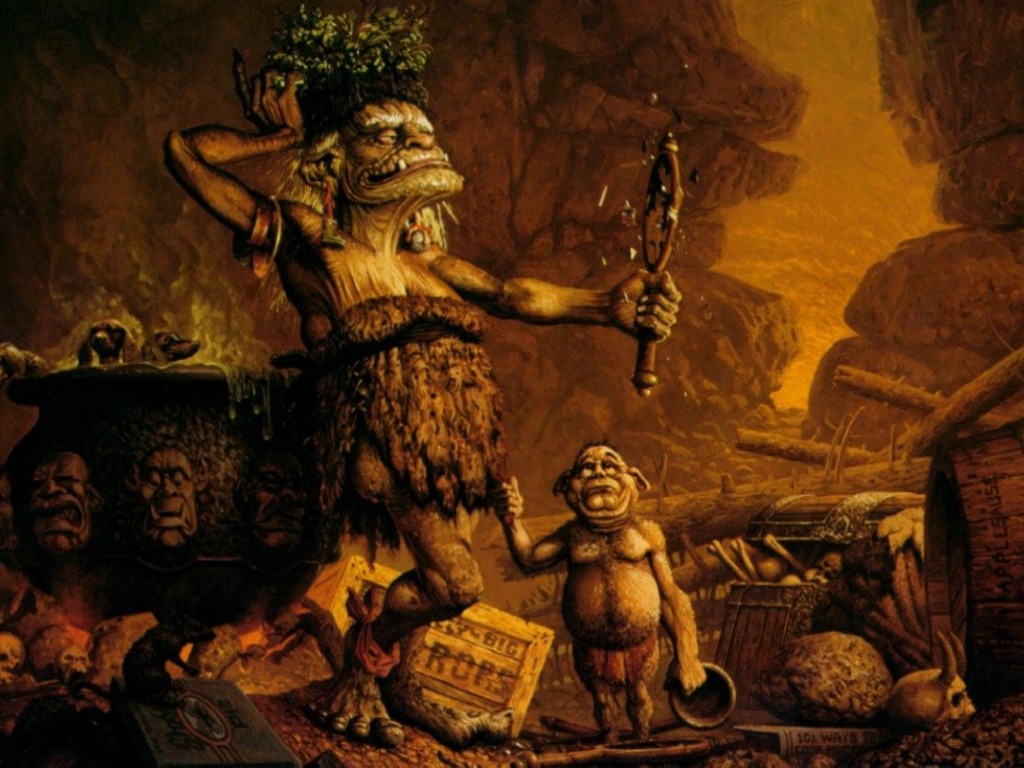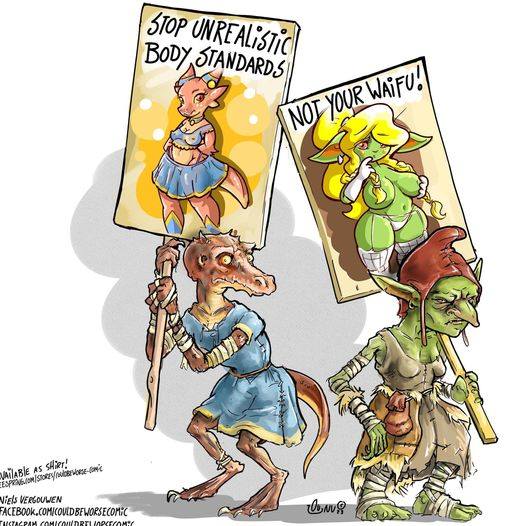Comeliness

Comeliness

|
|
|
|
|
|
|
|
|
|
|
|
Comeliness: Comeliness reflects
physical attractiveness, social grace,
and personal beauty of the character.
It is used to determine
initial reactions to the character, and
characters with a high comeliness
may affect the wills & actions of
others. While charisma deals
specifically with leadership and interactions
between characters,
comeliness deals with attractiveness and
first impressions.
Comeliness is not charisma. Charisma,
however, can affect comeliness.
After the first six attributes of a character
are determined, his or her
looks must be determined. Is the character
ugly, homely, plain, or
pretty? This characteristic is determined
by the comeliness roll. 3d6
are rolled and totalled. The resulting
number, between 3 and 18 inclusive, is modified:
<middle-age: -2 total, old: -3 total, venerable: -4 total>
As charisma is raised or lowered,
whether by disease, disfigurement, aging,
or artifacts, comeliness <aging does not affect CHA, though it should
affect COM> <use CON for COM adjustments?>
should be similarly affected on a point-for-point
basis (a loss of one
point of charisma equals one point of
comeliness equally lost).
<check this table>
| Charisma | Comeliness Modifier | Comeliness Range |
| 2 or less | -8 | -5 to 10 |
| 3 | -5 | -2 |
| 4-5 | -3 | 0 to 15 |
| 6-8 | -1 | 2 to 17 |
| 9-12 | 0 | 3 to 18 |
| 13-15 | +1 | 4 to 19 |
| 16-17 | +2 | 5 to 20 |
| 18 | +3 | 6 to 21 |
| 19+ | +5 | 8 to 24 |
In +addition+ to the
adjustment to comeliness based on charisma score,
characters of certain races must take
an additional adjustment to
their comeliness scores. This racial adjustment
applies only when the
reaction of characters of other races
is concerned, in similar fashion
to the way that racial adjustments for
charisma apply only to those of
other races. The penalties and bonuses
are these:
Half-orcs: -3
Dwarves, gnomes, dark
elf males: -1
* Hobbits, humans,
wild elves**, valley elves**: 0
* Half-elves, sylvan
elves, dark elf females: +1
* Gray elves, high
elves: +2
* -- Treat these pairs as being of the same race for purposes
of effective comeliness; e.g., halflings are just as attractive
(or repulsive) to humans as humans are to each other,
and vice versa.
** -- Wild elves and valley elves are not "of the same race" for purposes
of effective comeliness;
this concept only applies to halflings vis-a-vis humans and gray
elves vis-a-vis high elves. (D103.12) <needs to be corrected>
Comeliness will have the following effects
on creatures of human
sort. (This category includes, but is
not necessarily limited to, humans,
demi-humans, humanoids, giant-class, and
bipedal creatures
of human-like form and motivation.)
-16 or lower:
Those
viewing a character with comeliness this low are
repulsed and horrified, so as to turn
away or attempt to destroy the
creature so offensive to the sight. If
the individual with low comeliness
is powerful, the reaction will tend toward
escape, or reinforcement of
previously determined awe (horror)
reaction. If both viewer and creature
are of evil alignment, the effect is that
of a positive comeliness of the
same total.
-15 to -9:
Disgust,
evidenced by a tendency to look away, revile the
individual, and act hostile in general.
Under no circumstances will this
character be accepted by the viewers unless
all are of evil alignment,
so that the negative comeliness can be
regarded as positive.
-8 to 0: Aversion
and a desire to be away from so ugly a creature will
be evidenced by all viewers. If given
an excuse, those near the individual
will be hostile and openly aggressive;
otherwise they will merely tend
toward rejection.
+1 to +6:
As such an individual is simply ugly,
the reaction evidenced will tend toward
unease and a desire to get away from such brutishness as quickly as possible.
If given the opportunity, the character's
CHA
can offset ugliness, but this requires a fair amount of conversation and
interaction to take place.
+7 to +9: The
homeliness of the individual will be such that initial
contact will be of a negative sort. This
negative feeling will not be
strongly evidenced. High charisma will
quickly overcome it if any conversation
and interpersonal interaction transpires.
(Consider a dwarf with
16 charisma and a base comeliness roll
of 9; he or she will be at 8
when viewed by all creatures except other
dwarves -- who will see
him or her with comeliness adjusted by
+2 for charisma.)
+10 to +13: Plain to average comeliness; no effect on the viewer.
+14 to +17:
Interest in viewing the individual is evidenced by those
in contact, as he or she is good-looking.
The reaction adjustment is increased
by a percentage equal to the comeliness
score of the character.
Individuals of the opposite sex will seek
out such charcters, and
they will be affected as if under a fascinate
spell unless wisdom of <>
such individuals exceeds 50% of the character's
comeliness total.
+18 to +21:
The beauty of the character will cause heads to TURN &&& hearts
to race.
Reaction for initial contact is at a percent
equal to
150% of comeliness score. Individuals
of the opposite sex will be affected
as if under a fascinate spell unless
their wisdom exceeds two-thirds <>
of the character's comeliness total. Individuals
of the same sex
will do likewise unless wisdom totals
at least 50% of the other character's
comeliness score. Rejection of harsh nature
can cause the individual
rejected to have a reaction as if the
character had a negative
comeliness of half the actual (positive)
score.
+22 to +25: The stunning beauty
and gorgeous looks of a character
with so high a comeliness will be similar
to that of those of lesser
beauty (17-21), but individuals will actually
flock around the character,
follow him or her, and generally behave
so foolishly or in some manner
so as to attract the attention of the
character. The reaction adjustment
is double the score of comeliness; i.e.,
22 comeliness equals
+44%. Fascinate-like power will
affect all those with wisdom of less <>
than two-thirds the comeliness score of
the character. If an individual of
the opposite sex is actually consciously
sought by a character with
comeliness of 22-25, that individual will
be effectively fascinated unless
his or wisdom is 18 or higher. Rejection
is as above.
+26 to +30: Unearthly beauty of
this sort can be possessed only by
creatures from other planes -- demi-gods
& demi-goddesses and
deities of unusual sort. Reaction adjustment
is double comeliness
score. Fascinate-like power is
effective on all except those with wisdom
=equal= to at least 75% of comeliness,
except that 19 or higher wisdom <>
always allows a save vs. the power. An
individual of
the opposite sex who is consciously sought
by the possessor of such
unearthly beauty & comeliness will
always be under the "spell" of
the individual with such beauty unless
he or she has wisdom of 20 or
more.
The fascinate-like
power of high comeliness is similar to the 2nd-level
illusionist spell of the same name. Those
subject to this power will be
captivated by the user, and treat him
or her as a trusted friend, mentor,
and companion. A save vs. Spell will negate
the effect but
if the comeliness is not magical in nature,
then dispel magic,
anti-magic spells, and similar spells
will not affect the fascination effect.
Fascinated creatures will follow
the orders of characters with high
comeliness, provided a roll of 3d6 does
not exceed the comeliness of
the character. Requests that are not in
the best interest of the creature
get a +1 to the die, while those that
are hazardous can gain up to
+6 or higher on the die roll. If the roll
is higher than the user's comeliness,
the fascinate-effect is broken.
If a once-fascinated creature has been
badly treated and breaks free
of this entrapment, the creature will
react as if the character's
comeliness was a negative amount. If the
creature has been well
treated, it may still be friendly to the
character even after the fascination
has worn off.
The effect of one's comeliness upon others
is temporary; once a character
is known to other characters or creatures,
its effect is negated
and charisma is used to determine reactions
& followers. In this
way characters of high comeliness &
low charisma may attract interest,
but not long-term followers & allies
(beauty being only skin
deep).
The effects of the fascinate power
do not affect the abilities of the individual
with respect to fighting, casting of spells,
etc., and in no way
reduces the subject character to a zombie-like
state, a puppet for the
high-comeliness character. Actions performed
by a character while
fascinated may affect alignment
(though they would have a good +addition+
to the comeliness check, say +3 or +4).
Magic can mildly and temporarily affect
the comeliness of a creature.
Illusion-based spells such as change
self and alter self will raise or <>
lower comeliness by a maximum of 1 point,
no matter what the final
form is. Illusions of characters or creatures
with high comeliness are
effective only for a single round, as
the nature of the fascinate is such <>
that the character affected concentrates
more fully on the illusion,
weakening its effectiveness. Polymorphed
figures raise or lower
comeliness by 2 points from the original,
due to suble social clues
that are not visual but still perceived,
while shapechange confers full <>
comeliness of the final form.

CHARACTER ABILITIES
EXPLANATION OF ABILITIES
Comeliness: This character attribute
is fully described on pages 6
and 7 of this volume. This “ability,”
while it might more properly be
called a characteristic, does have effects
(in game terms) upon those
viewing or reacting to the character.
As shown above, human player
characters created for a certain class
have a better chance to be
gifted with above-average comeliness (or,
more accurately, it may be
assumed that certain classes are more
of an attraction for relatively
beautifullhandsome characters).
Q: Some of the characters
described by Gary Gygax in your magazine
have an attribute labeled
CO. What is this?
A: CO stands for Comeliness,
a new attribute described by Gary
Gygax (in issue #67 of DRAGON
magazine) to represent physical
beauty/handsomeness. Unlike
other attributes such as
strength, comeliness has
a range from -8 (for the ugliest half-orc)
to +25 (for the most beautiful
elf).
Scores of +10 to +13 are average.
The use of a comeliness
attribute is up to the DM and the
players of an AD&D
group.
Blue
Blaster wrote:
Gary, how did shaving take
place during the middle-ages? Was there any small thin blade like now or
was a stone used or what? The reason I want to know is because it is applicable
to the world of the TSR ADandD 1E rpg. If a way to shave existed during
the middle-ages, it can be applied to the game world.

Steel was surely available
in the middle ages,
so straight razors of various
sorts,
along with knife &&
dagger
blades,
were used to shave.
Cheerio,
Gary
<small note at Dragons
of Winter Night, page 244:
a creature polymorphed into
another creature affects others, and is affected by others, according to
the present (polymorphed) Comeliness / Race
there's a bit of confusion
over love & lust, there, but it's safe to say that the
passage applies to Comeliness>
<"the goblins shouted
for Tika to dance again", DWN.256>
<there is an earlier
reference in one of the DL sources about draconians being affected by human
comeliness, DL2, I think>
